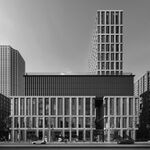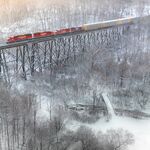But it isn't consistant. Why does the B-D need 110 minutes to make a round trip in the middle of the day, but only 97 at night?
The signals haven't changed. There aren't fewer stations being served. The route isn't shorter.
And thus my point. The number of stops isn't the final bearing on how long a route will take to run. It does have a bearing, yes, but it's most certainly not the only one.
Dan
Toronto, Ont.
I think we are saying the same thing, sort of. On the subway, the running time between stops doesn't change over the day. Once you know how many stops there are, and how far apart they are, you have a constant running time.
What changes is dwell time in stations. Trains take longer to load/unload in peak periods, yes. That accumulates over the length of the run, so you schedule longer running times at peak. However, on leaving the platform, a train takes exactly as long to reach the next station as they would at any other time of the day. (OK, if trains bunch up, they may run on yellow lights at slower speed, but even at rush hour the schedule tries to avoid this.)
I agree- If you assume that LRT always stops at every stop, then it's the same for LRT. The number of stops doesn't matter, dwell time is what influences trip time. I'm questioning if this is the scenario being designed. In the extremities, if we design with the intermediate local stops included, these stops may have no one boarding or requesting a stop. Some LRT's will blow right through the stop, just as the 501 frequently does at Colborne Park and South Kingsway. That results in a much more variable running time than if they are designed to stop everywhere.
You can schedule the same way as the subway - allow more time at peak, on the assumption that more LRT's will stop more often at those times, and for longer. But there is a limit to how often this will be true. You will have a greater number of cases where the LRT gets ahead of schedule.
If you limit the stops to the main intersections where there is heavy transfer business, then the actual operation most closely approaches subway conditions....the LRT stops at every stop. We're back to dwell time as the variable factor.
The issue is not "more" stops versus "less" stops or "longer" trips versus "shorter" trips - it's consistency. Variability will play havoc with traffic priority signalling or timed signalling. The solution is inevitably operators electing to coast....there is an art to streetcars coasting towards a stale green when the operator wants to hit the yellow. They use the forced stop to kill time through one light cycle.
The point I am beating to death is, build in whatever number of stops you want....but don't allow coasting to creep into the design. Low-use stops influence schedule which influences coasting.
- Paul




